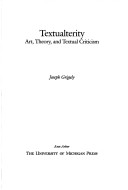Editorial Theory & Literary Criticism
1 total work
How might it be that works of art and literature are not just made, but unmade, remade, and made over? Joseph Grigely argues that it is the very nature of art to incorporate change by editors and conservators, and as it is resituated in different publications and exhibition sites. Asserting that the common editorial practice of creating eclectic texts is essentially a eugenic practice based on Romanticism's desire for racial and textual purity, Grigely reconceives the notion of textual difference, or textualterity. Grigely draws not only on a wide range of cultural transformations in nineteenth--and twentieth-century literature-- including Thomas Bowdler's 1818 edition of Shakespeare and the Reader's Digest condensed edition of Tom Sawyer--but on a detailed exploration of recent controversies in the arts to argue for the need to understand these textual transformations as fundamental cultural phenomena. In a concluding chapter devoted to Jackson Pollock's Number 1, 1950 (Lavender Mist), Grigely shows how the title and the media of Pollock's painting have been changed (by friends, curators, and an inch-long cicada) in ways that ultimately affect our conceptualization of the work of art as a timeless object. By moving between the scholarly territory of textual research and the critical territory of contemporary conceptual art, Grigely creates a transdisciplinary discourse that engages current discussions on framing, authorial intentions, collaborative authorship, and moral rights. Textualterity will be essential reading for textual critics, art historians and theorists, and students of cultural theory and history. Joseph Grigely is Associate Professor of Art, Universityof Michigan.
